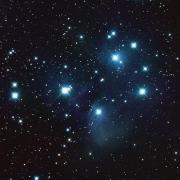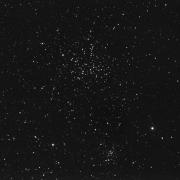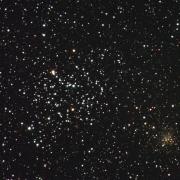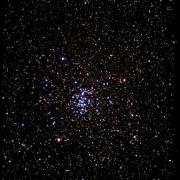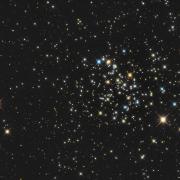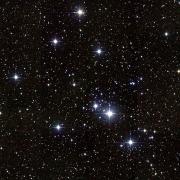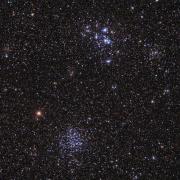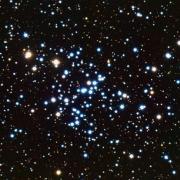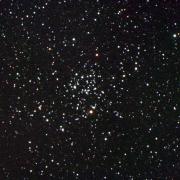One of the many delights of observing the Winter night sky is noting the diverse range of Open Clusters visible to the naked eye, binoculars and telescope alike. But what is an Open Cluster?
Open Clusters: clusters of young stars (usually no older than 500 million yrs) of roughly the same age, born from the same large cloud of gas (like the Orion Nebula) and are now only just starting to slowly move away from their stellar nursery (due to the pull of other stars in the spiral arms of our galaxy). Open clusters sometimes, called Galactic clusters, range in size from a few tens of stars up to a few thousand stars. Related to open clusters are Associations, very loose groupings of stars of common origin.
Let us now take a tour of the more prominent open clusters visible in the winter sky starting with M45, the Pleiades or "Seven sisters", found to the upper right of Aldeberan, in Taurus. This distinctive cluster is one of the jewels of the heavens, especially when viewed at low power, i.e. with binoculars. In a scope up to 50 stars are visible, though not in the same field. The cluster actually contains over 350 members lying some 400 light-years away. It is estimated that the cluster is around 100 million years old. A good example of a loose cluster is the Hyades, the “v” shape of stars dominated by Aldeberan in Taurus. This is an illusion as Aldeberan is half the distance of the Hyades members.
Next find the constellation of Auriga high above Taurus and marked by the prominent star Capella. Using binoculars sweep the area between Theta and Iota Aurigae you will notice 3 faint hazy patches, these are the open clusters M36, M37 and M38.
M38 (top) and M36 are seen in the same binocular field, M37 is situated to the lower left. For small scopes, M36 is probably the finest of the trio - a pretty knot of jewel like blue stars seen against the hazy light of dozens of cluster members. It lies 4000 light-years away.
For larger scopes M37 is the more impressive, appearing more like a loose Globular cluster than an open cluster. It is 4,500 light-years away. M38 is better to resolve than M37, though fainter than M36, it lies 4000 light-years away.
Now sweep South-East towards Gemini to find a large misty patch close by the stars marking Gemini’s right foot. This is M35, a large open cluster containing over 2,000 members some 3,000 light-years away. A small scope will reveal many of the brighter stars.
Travel East, beyond Caster and Pollux to find the fainter zodiacal constellation of Cancer. On good nights of seeing you may spot with the naked eye a fuzzy patch, this is M44, the “Beehive cluster". Again to appreciate this cluster use low power, note the colour differences of the cluster members. M44 lies 500 light-years away, contains around 400 stars and is quite old, 400 million yrs. A second open cluster found in Cancer well to the South-East of M44, and above Hydra’s head an equivalent distance, is M67. It is a nice object in small scopes, not as impressive as M44 but more interesting.
Most open clusters are formed in the plane of the galaxy, where the effects of gravity eventually disperse the cluster members, M67 is unusual in that it lies 1,500 light-years above the galactic plane, some 2,500 light-years away, well away from the gravitational pull of other stars and consequently the cluster has stayed and evolved together. The estimated age of the 500 cluster members is around 7 billion years, older than our solar system.
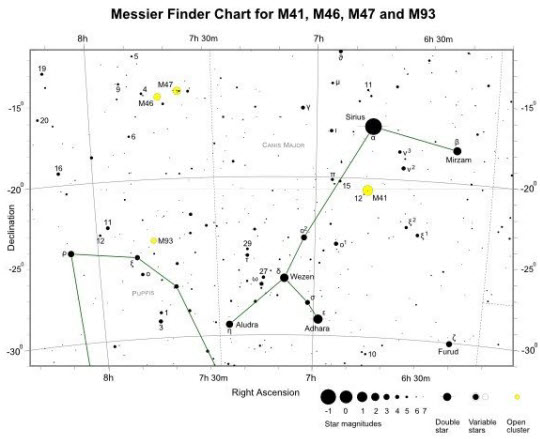
From Cancer, head southwards to find the brightest star in the sky, Sirius, in Canis Major. Place dazzling Sirius at the top of your binocular / finder scope field and move slightly downwards. You should find a lumpy patch of light; this is the open cluster M41 a rather pleasing collection of 3 dozen or so stars visible in small instruments. M41 is another distant cluster lying over 2,100 light-years away.
Next, sight from Mirzam (the bright-ish star to the right of Sirius) through Sirius and continue for twice that distance to an area in the constellation of Puppis ( you can also sight down through Orion’s belt to this same area). Through binoculars / finder scope, a small cloud of light should be visible, this is the open cluster M47, and under dark skies M46, another open cluster is just visible next to M47.
In small scopes M47 resolves easily into a group of stars, M46 still resembles a hazy patch of light, though in 6’’ scopes or larger M46 is the more impressive. Even though these clusters appear next to each other in the sky, in reality M46 is over 3 times further away than M47, 5,000 light-years compared to 1,500 light-years. A third open cluster in Puppis can be found 2-3 binocular fields to the South-East of M46/7, though M93 can be hard to pick out in the “murk” above the South horizon.
Returning to Sirius imagine a line extended to Procyon, the bright star up to the North-East. in Canis Major. A third of the way along this trajectory, in the constellation of Monoceros you will find the faint open cluster M50. a collection of 100 stars 3,000 light-years distant
Our final port of call is in Orion, or should I say it is Orion. For apart from “ruddy” Betelguese which is closer, many of the stars situated in and around the main body of Orion are associated. Most are hot blue stars (Rigel) formed from the same giant molecular cloud several hundred million years ago which are now drifting apart.
I have concentrated on winter open clusters visible in the South aspect of the night sky. There are many other well placed open clusters in the northern half, but these can wait for another time. Good hunting!
Image Credits: NASA
- Log in to post comments

